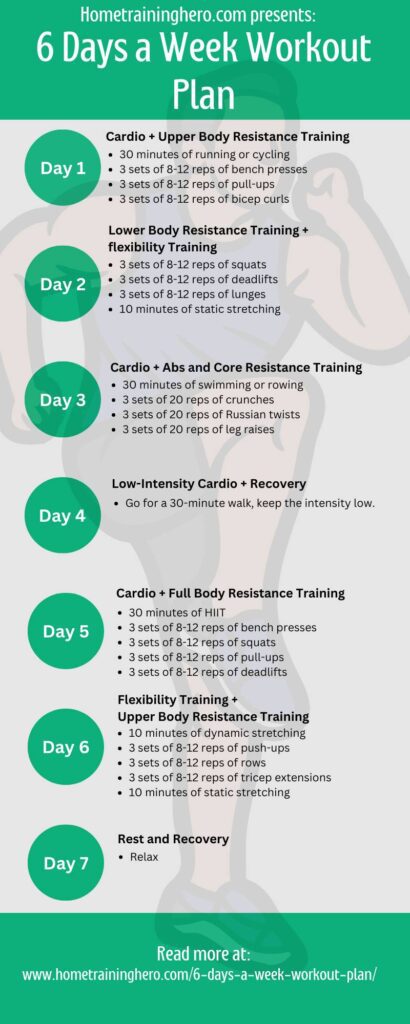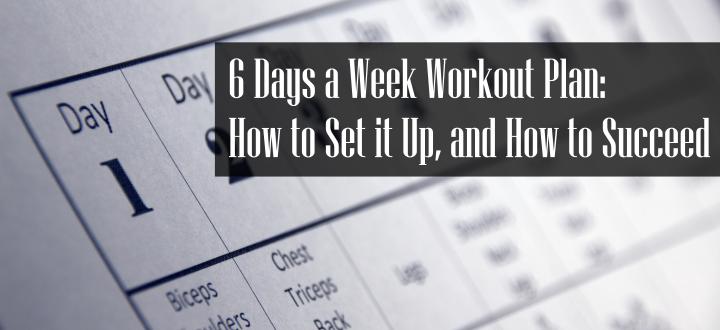A 6 days a week workout plan involves exercising, you guessed right, six days a week – with one day reserved for rest and recovery.
This type of workout plan can be highly effective for several reasons:
For one, it allows for ample time to focus on specific muscle groups or fitness goals. Additionally, it can help you build a consistent exercise routine, which is essential for maintaining long-term fitness.
In this article, we’ll explore the components of a well-rounded 6-day workout plan, how to structure a plan, and actionable tips for success. Whether you’re a seasoned gym-goer or just starting, this article will provide the information you need to create an effective 6-day workout plan.
Contents
Types of Workouts to Include in a 6-Day Plan
A well-rounded 6-day workout plan should include a mix of cardiovascular exercise, resistance training, and flexibility training. Let’s explore each of these types of workouts in more detail:
Cardiovascular Exercise (Cardio)
Cardiovascular exercise – popularly known as cardio, is any type of activity that raises your heart rate and increases oxygen flow to your muscles. Cardio is essential for improving cardiovascular health, burning calories, and boosting endurance. There are loads of different types of cardio exercises to choose from, including:
- Running: Running is a well-known form of cardio that can be done either on a treadmill or outdoors. It’s a high-impact exercise that can help improve bone density and cardiovascular fitness.
- Cycling: Cycling is a low-impact exercise that can be done on a stationary bike or outdoors. It’s an excellent option for those with joint pain or injuries.
- Swimming: Swimming is another low-impact exercise that can be great for those with joint pain or injuries. It’s also an excellent full-body workout that can help improve cardiovascular fitness and muscular endurance.
- High-Intensity Interval Training (HIIT): HIIT involves short bursts of high-intensity exercise followed by periods of rest or low-intensity exercise. It’s an effective way to burn calories and work your cardiovascular fitness in a short amount of time.
Resistance Training
Resistance training, also known as strength training, involves using weights, your body weight, or resistance bands to build strength and muscle mass. Resistance training is essential for improving overall fitness, as well as preventing injury and maintaining healthy bones. There are many different types of resistance exercises to choose from, including:
- Squats: Squats are a compound exercise that works your lower body – including the quads, glutes, and hamstrings.
- Deadlifts: Deadlifts are a superb compound exercise that works your entire body, including your legs, back, and core.
- Bench Press: The bench press is a compound exercise that works your chest, shoulders, and triceps.
- Pull-Ups: Pull-ups are excellent for building upper body strength, especially in your back and arms.
Flexibility Training
Flexibility training, also known as stretching, involves moving your body to stretch your muscles and improve your range of motion. Flexibility training is important for maintaining joint health, preventing injury, and improving posture. There are several different types of flexibility exercises to choose from, including:
- Static stretching: Static stretching involves holding a stretch for a set amount of time, usually around 30 seconds.
- Dynamic stretching: Dynamic stretching involves moving your body through a range of motion, often mimicking the movements you’ll be doing during your workout.
- Yoga: Yoga is a popular form of flexibility training incorporating mindfulness and relaxation techniques.
By incorporating all three types of workouts into your 6-day workout plan, you can build a well-rounded routine that helps you achieve your fitness goals while keeping you healthy and injury-free.
Structuring a 6-Day Workout Plan
Now that we’ve covered the types of workouts to include in a 6-day plan, let’s talk about how to structure your workouts throughout the week. Here’s an example of a 6-day workout plan that includes all three types of workouts:
Day 1: Cardio + Upper Body Resistance Training
- 30 minutes of running or cycling
- 3 sets of 8-12 reps of bench presses
- 3 sets of 8-12 reps of pull-ups
- 3 sets of 8-12 reps of bicep curls
Day 2: Lower Body Resistance Training + flexibility Training
- 3 sets of 8-12 reps of squats
- 3 sets of 8-12 reps of deadlifts
- 3 sets of 8-12 reps of lunges
- 10 minutes of static stretching
Day 3: Cardio + Abs and Core Resistance Training
- 30 minutes of swimming or rowing
- 3 sets of 20 reps of Crunches
- 3 sets of 20 reps of Russian twists
- 3 sets of 20 reps of Leg Raises
Day 4: Low-Intensity Cardio + Recovery
- Go for a 30-minute walk, keep the intensity low.
Day 5: Cardio + Full Body Resistance Training
- 30 minutes of HIIT
- 3 sets of 8-12 reps of bench presses
- 3 sets of 8-12 reps of squats
- 3 sets of 8-12 reps of pull-ups
- 3 sets of 8-12 reps of deadlifts
Day 6: Flexibility Training + Upper Body Resistance Training
- 10 minutes of dynamic stretching
- 3 sets of 8-12 reps of push-ups
- 3 sets of 8-12 reps of rows
- 3 sets of 8-12 reps of tricep extensions
- 10 minutes of static stretching
Day 7: Rest and Recovery
Of course, this is just one example of a 6-day workout plan, and it’s important to tailor your plan to your fitness goals, preferences, and physical abilities. However, this plan does include all three types of workouts and provides a good balance of cardio, resistance training, and flexibility training throughout the week.

5 Actionable Tips for Success
- Listen to your body: Pay attention to your body and adjust your workouts as needed. If you’re feeling sore or tired, take a rest day or modify your workout to be less intense.
- Fuel your body: Eating a healthy and balanced diet is essential for fueling your body for workouts and aiding in recovery. Eat plenty of protein, whole grains, fruits, and vegetables.
- Stay hydrated: Drinking enough water before, during, and after your workouts are essential for staying hydrated and helping your body function properly.
- Get enough sleep: Sleep is vital for muscle recovery and your overall health. Aim for at least 7-8 hours of sleep per night.
- Mix it up: To prevent boredom and keep your body challenged, mix up your workouts regularly by trying new exercises or incorporating new equipment.
By following these tips and tailoring your 6-day workout plan to your needs, you’ll be far on your way to reaching your fitness goals and maintaining good health.
Read more:
- How to get Maximum Results From Workout Routines: 8 Science-Proved Hacks
- 4 Actionable Hacks When You See No Results From Working Out
Frequently Asked Questions (FAQ)
Yes, 6 days a week is a good amount of time to work out, as long as you’re giving your body adequate rest and recovery time.
The best 6 day workout routine will depend on your goals and fitness level, but a popular option is a split routine where you focus on different muscle groups each day.
Yes, you can build muscle training 6 days a week if you give your body enough rest and recovery time and fuel it with proper nutrition.
A 6 day workout split can be too much if you’re not giving your body enough rest and recovery time or if you’re not properly fueling it with nutrition.
Signs of overtraining can include fatigue, decreased performance, increased risk of injury, mood changes, and decreased immunity.
Yes, you can lift weights 6 days a week as long as you’re giving your body enough rest and recovery time and fueling it with proper nutrition.
The time it takes to see results from working out 6 days a week will depend on various factors such as your starting fitness level, goals, and nutrition – but you may start to see some changes within a few weeks to a few months.
A pull workout program focuses on exercises that primarily work the muscles involved in pulling movements; such as the back, biceps, and rear shoulders.
A push workout plan focuses on exercises that primarily work the muscles involved in pushing movements; such as the chest, shoulders, and triceps.
Whether it’s better to work out 3 days a week or 6 will depend on your goals, schedule, and fitness level. Both options can be effective if you’re properly fueling your body with nutrition and giving it enough rest and recovery time.
The length of a workout will depend on various factors such as your fitness level, goals, and workout intensity, but a typical workout can range from 30 minutes to 90 minutes.
Final Words
A 6-day workout plan can be an effective way to achieve your fitness goals and maintain good health. By incorporating a balance of cardio, resistance training, and flexibility training, you can improve your cardiovascular endurance, build strength and muscle mass, and improve your flexibility and mobility.
Remember to listen to your body, fuel it with a healthy diet, stay hydrated, get enough sleep, and mix up your workouts to prevent boredom and keep your body challenged.
With dedication and consistency, a 6-day workout plan can help you achieve your fitness goals – and lead to a healthier, happier life.
If you want to learn more about strength training, visit my strength-building archive – LOADED with actionable tips and hacks!


